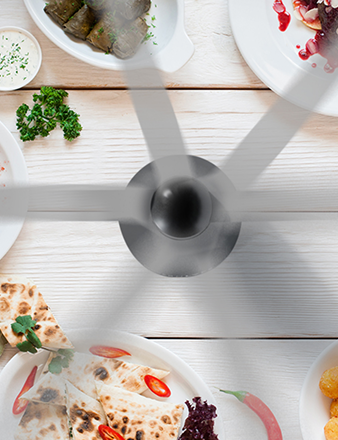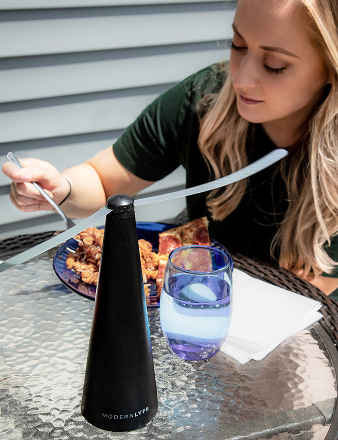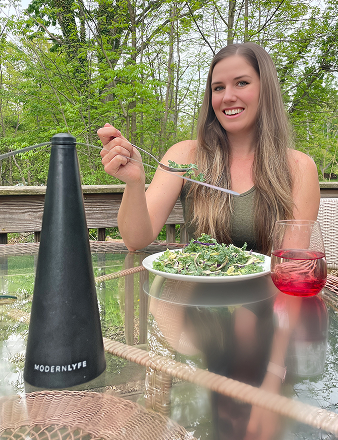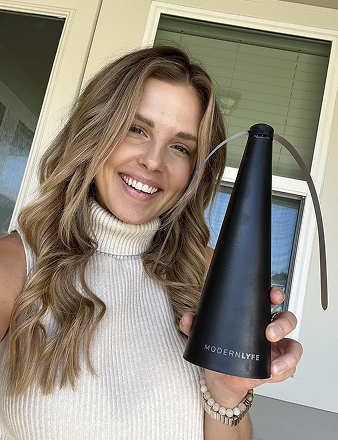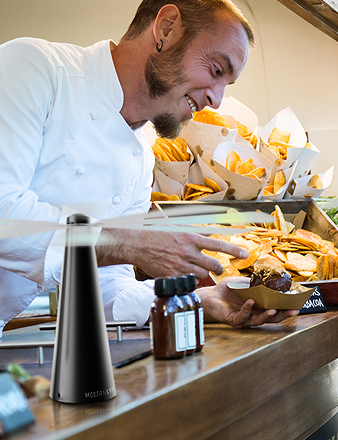Restaurant cleanliness isn't just a daily task—it's the core promise you make to every person who walks through your doors. These standards are a system of protocols that ensure safety, build your brand, and protect your bottom line. A spotless restaurant isn't just nice to have; it's a non-negotiable part of your business strategy.
Why Cleanliness Is Your Restaurant's Greatest Asset
In the restaurant world, cleanliness is everything. It’s the immune system of your operation, fighting off invisible threats that can damage your reputation and harm your customers. While meeting health codes is mandatory, exceptional hygiene standards are what separate good restaurants from great ones. It's what builds loyalty and prevents the kind of foodborne illness outbreaks that can shut a business down permanently.
The stakes are high. The World Health Organization estimates that 600 million people get sick from contaminated food each year, and 420,000 of those cases are fatal. This statistic is a powerful reminder of the real-world consequences of letting standards slip. You can read more about these critical food safety findings on SafetyCulture.
To build a comprehensive hygiene strategy, focus on four key pillars that work together to create a safe, welcoming, and successful restaurant environment.
The Four Pillars of Restaurant Hygiene
| Pillar | Core Focus | Impact on Business |
|---|---|---|
| Legal Compliance | Adhering to local, state, and federal health codes and food safety regulations. | Prevents fines, forced closures, and legal trouble. This is the absolute bare minimum. |
| Customer Experience | Creating a visibly clean and sanitary environment that makes guests feel safe and comfortable. | Drives repeat business, positive reviews, and word-of-mouth marketing. |
| Staff & Food Safety | Implementing protocols that prevent cross-contamination and the spread of foodborne illnesses. | Protects public health, reduces food waste, and ensures operational efficiency. |
| Brand Reputation | Maintaining consistent cleanliness to build a brand known for quality, care, and professionalism. | Establishes trust and sets your restaurant apart from the competition. |
Ultimately, these pillars support your entire business. If one crumbles, the others are at risk.
The Foundation of Customer Trust
A sparkling clean restaurant sends a powerful message: "We care about you and our craft." When guests see spotless restrooms, gleaming tables, and hygienic staff, they feel secure. That feeling of safety turns a one-time visitor into a loyal regular.
A landmark Zagat survey revealed that 53% of diners put cleanliness and sanitation at the very top of their list when choosing a restaurant. For over half your potential customers, cleanliness matters more than your menu, prices, or even service.
From Compliant to Excellent
Meeting the health inspector's checklist is just the starting point. The goal is to build a culture of cleanliness, where every team member is invested in maintaining an impeccable space. This mindset doesn't just protect you from violations; it creates an environment people want to be in.
This proactive approach defines operational excellence. Sometimes, achieving this level requires expert help, and partnering with specialized restaurant cleaning services can make a significant difference.
For a deeper dive into specific protocols, our complete guide to food service hygiene standards is an excellent resource. Mastering cleanliness isn’t a chore—it’s one of the most powerful business tools you have.
Decoding Health Codes and Inspection Checklists
Health codes can seem complex, but they’re built on commonsense principles designed to keep everyone safe. Understanding these rules is the first step toward building a food safety culture that goes beyond just passing an inspection.
Think of the health inspector's checklist as a roadmap, not a final exam. Inspectors are trained to spot small risks that can escalate into major problems. They know exactly where to look for weaknesses in a restaurant's cleanliness standards.
The Inspector's Core Focus Areas
Inspectors consistently focus on a few critical areas. Master these, and you’re on your way to running a safe, compliant restaurant. They are looking for proof that your systems work every day.
- Temperature Control: This is critical. Hot food must stay hot (above 140°F), and cold food must stay cold (below 40°F). The range in between is the "danger zone" where bacteria multiply rapidly.
- Cross-Contamination Prevention: This means having strict rules for keeping raw meats separate from ready-to-eat foods, using color-coded cutting boards, and sanitizing every surface between tasks.
- Personal Hygiene: It all comes down to your team. Inspectors will verify proper handwashing protocols, check for clean uniforms, and ensure sick employees stay home.
- Chemical Safety: Cleaning chemicals are essential but must be handled correctly. This means storing them away from food prep areas, ensuring every bottle is labeled, and using them exactly as instructed.
A failure in any of these areas can lead to an immediate violation. To learn more about common issues, see our guide on restaurant health code violations.
Introducing the HACCP Framework
The best restaurants don't just react to problems—they prevent them. That’s the core principle of the Hazard Analysis and Critical Control Points (HACCP) system. It’s a systematic approach to identifying potential food safety hazards and establishing controls to manage them.
HACCP is more of a mindset than a rulebook. It empowers your team to think like food safety experts, identifying risks at every step—from receiving ingredients to serving the final dish.
Adopting this framework shifts your operation from reactive to proactive. This not only makes your food safer but also streamlines kitchen operations, reduces waste, and prepares you for any inspection.
This infographic shows how impeccable cleanliness connects your restaurant's success to the loyalty, safety, and reputation you've worked hard to build.
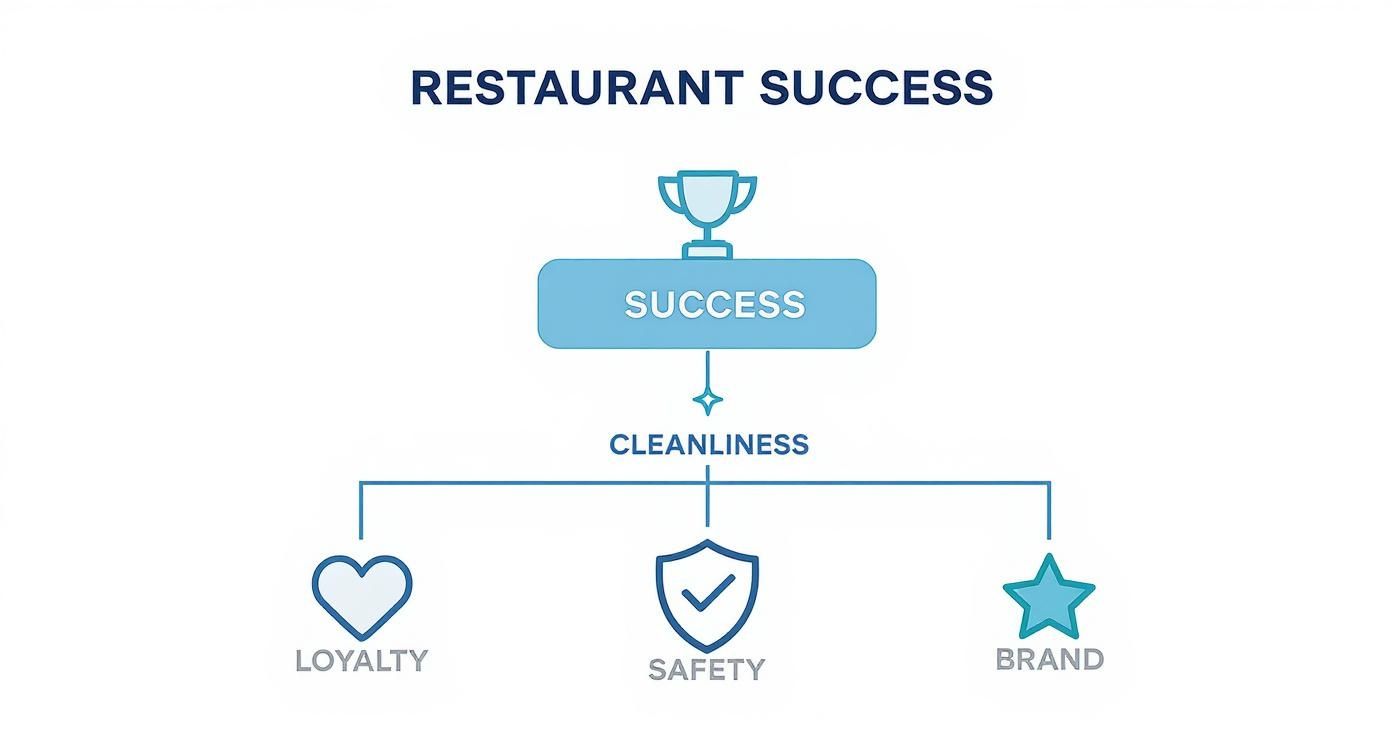
Without a solid foundation of cleanliness, the pillars supporting your business—like brand trust and guest safety—will eventually fail.
From Checklist to Culture
Passing an inspection is a one-time event. The real goal is to embed high standards into your restaurant's DNA. It’s about creating a culture where every team member understands why these rules matter and takes ownership in keeping the establishment spotless and safe.
This approach transforms compliance from a chore into a source of shared pride. To master health codes and ace inspections, you can reference an ultimate guide to a sparkling kitchen deep clean. Building this culture ensures your restaurant is always inspection-ready, delivering a safe and exceptional experience every day.
Actionable, Zone-Based Cleaning Systems

Vague instructions like "go clean something" lead to inconsistent results and missed spots. A systematic, zone-based approach transforms chaos into an organized, efficient, and accountable process that keeps your restaurant spotless.
Each area of your restaurant has unique cleaning needs. Your strategy must reflect that.
By dividing your restaurant into logical zones—Front of House (FOH), Back of House (BOH), and Restrooms—you create immediate clarity. This structure ensures every corner receives the right attention on a sensible schedule. It’s about working smarter, not harder.
Defining Your Front of House Zone
The Front of House (FOH) is your first impression. According to a Zagat survey, 53% of diners rank cleanliness as their top priority when choosing a restaurant. This zone includes everything guests see and touch.
Daily tasks focus on maintaining a pristine appearance during operating hours.
FOH Daily Checklist:
- Wipe and sanitize all tables and chairs between each seating.
- Clean and sanitize menus, condiment holders, and payment terminals.
- Sweep and mop floors, focusing on entryways and high-traffic areas.
- Clean all glass, especially entrance doors and windows, to remove smudges.
Weekly tasks go deeper, addressing grime that accumulates over time. Monthly deep cleans tackle larger projects to keep the space feeling fresh.
A systematic cleaning schedule is preventative maintenance. Consistent, zoned cleaning stops the buildup of dirt and bacteria, ensuring your establishment always feels welcoming.
Mastering the Back of House Zone
The Back of House (BOH) is your operational core, and its cleanliness is non-negotiable for food safety. This is where cross-contamination risks are highest. A spotless kitchen is a fundamental requirement for passing health inspections and protecting your customers.
Daily BOH cleaning centers on sanitation and safety. The goal is to reset the kitchen at the end of every shift to prevent bacterial growth. A strict "clean-as-you-go" policy is essential.
BOH Daily Checklist:
- Clean and sanitize all food-contact surfaces, including prep tables, cutting boards, and slicers.
- Thoroughly clean all cooking equipment like grills, fryers, and stovetops.
- Wash and sanitize all dishes, utensils, and cookware using a three-sink method or commercial dishwasher.
- Empty and sanitize all trash and recycling bins to prevent pests and odors.
Weekly and monthly BOH tasks are more intensive, involving equipment breakdowns for deep degreasing and scrubbing hard-to-reach areas.
Conquering the Restroom Zone
A restaurant's restroom can define the entire customer experience. Even with world-class food and service, a dirty restroom leaves a lasting negative impression. This zone requires constant vigilance and a strict cleaning schedule.
Frequent checks and clean-ups throughout the day are essential. During peak hours, a check every 30-60 minutes can prevent small messes from becoming major issues.
Restroom Daily Checklist:
- Clean and sanitize toilets, urinals, and sinks multiple times daily.
- Restock soap, paper towels, and toilet paper before they run out.
- Wipe down countertops, mirrors, and baby changing stations.
- Sweep and mop floors, and empty trash receptacles regularly.
This table provides a clear overview of how a structured cleaning schedule works across different zones.
Sample Restaurant Cleaning Schedule At-a-Glance
This table outlines how daily, weekly, and monthly tasks are organized by zone to create a comprehensive cleaning system.
| Zone | Daily Must-Dos (Examples) | Weekly Resets (Examples) | Monthly Deep Cleans (Examples) |
|---|---|---|---|
| Front of House | Sanitize tables, menus, high-touch surfaces; mop floors. | Dust light fixtures; clean upholstery on chairs/booths. | Professionally clean carpets; wash windows inside and out. |
| Back of House | Clean cooking equipment; sanitize prep surfaces; wash dishes. | Degrease fryers; delime dishwashers; clean floor drains. | Clean exhaust hoods and filters; empty and sanitize walk-ins. |
| Restrooms | Clean and sanitize all fixtures; restock supplies; mop floors. | Scrub tile grout; clean and polish all chrome fixtures. | Deep clean walls and partitions; descale faucets and toilets. |
By implementing a zone-based system with clear daily, weekly, and monthly checklists, you eliminate guesswork. Your team knows exactly what to do and when, ensuring consistently high restaurant cleanliness standards and building a five-star reputation.
The Financial Impact of Your Cleaning Standards
Many owners view cleaning as a cost center, but that’s a critical mistake. Your restaurant cleanliness standards are not a drain on profits; they are a smart investment in your business's financial health.
When sanitation slips, the costs appear quickly and hit your bottom line hard. These are not just obvious expenses; they are silent drains that can sink an otherwise successful restaurant.
The Hidden Costs of Poor Hygiene
Sloppy cleaning creates a domino effect that directly impacts revenue. A poorly wiped prep station leads to cross-contamination, causing food to spoil. Suddenly, you're throwing money away.
- Skyrocketing Food Waste: Improperly cleaned storage and prep areas breed bacteria, leading to spoilage. Every discarded item is a direct hit to your profit margin.
- Pest Control Nightmares: Crumbs, spills, and grease buildup are an open invitation for pests. Eradication is an expensive, recurring battle.
- Equipment Breakdowns: Grease on your fryer or grime in your oven forces machinery to work harder, leading to costly repairs and a shorter lifespan.
- Painful Health Code Fines: Failing a health inspection comes with hefty financial penalties that can disrupt your budget for months.
The financial bleed is real. Poor sanitation is a major driver of food waste, which costs U.S. restaurants $162 billion annually. Learn more about the true cost of restaurant food waste on The Restaurant HQ.
Shifting from Expense to Investment
It’s time to see cleaning as protecting revenue, not just spending money. When you provide your team with proper training, tools, and protocols, you're investing in your bottom line.
A 2021 study found that customers were willing to spend twice as much per month at restaurants they perceived as clean and safe compared to those they viewed as unsanitary.
That single statistic should change your perspective. Money spent on cleaning isn't gone—it's working for you, building customer trust that translates directly into higher sales and more frequent visits.
A spotless restaurant doesn't just prevent financial losses; it actively grows your business by improving efficiency, reducing risks, and building deep customer loyalty. That's the real power of clean.
Essential Cleaning Workflows for Your Staff
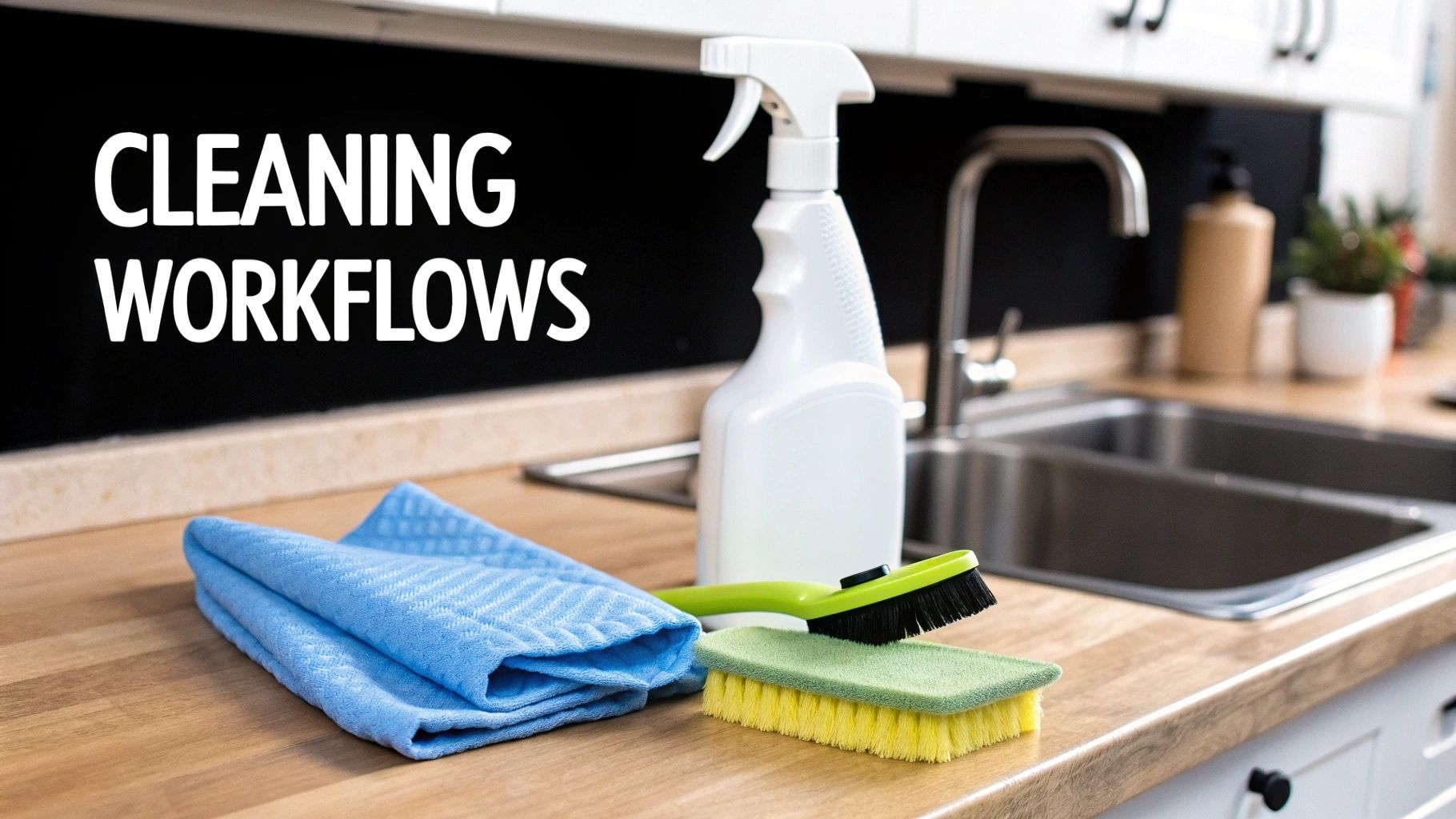
Excellent restaurant cleanliness standards depend on consistency. Without clear, repeatable workflows, even the best intentions fail. These routines turn good habits into muscle memory for your entire team.
Think of these workflows as recipes. Just as a chef follows precise steps, your staff needs a clear guide for crucial cleaning tasks. This removes guesswork and ensures a safe, spotless environment every time.
Mastering the Three-Sink Method
The three-sink method is the gold standard for washing dishes by hand in a commercial kitchen. It's a systematic process designed to sanitize everything properly and kill harmful bacteria. Getting this wrong is a fast track to a major health code violation.
The process is straightforward but requires strict adherence to the correct order.
-
Sink One: Scrape and Wash. Scrape leftover food into the trash. Then, wash the item in the first sink with hot, soapy water (at least 110°F) to cut through grease and grime.
-
Sink Two: Rinse. Move the item to the second sink and rinse it thoroughly with clean, warm water. This step removes lingering food and soap that could neutralize the sanitizer.
-
Sink Three: Sanitize. Fully submerge the item in the third sink, which contains either a chemical sanitizing solution mixed to the proper concentration or hot water held at 171°F. Items must remain submerged for the required contact time (usually 30-60 seconds). Always verify local health codes and sanitizer instructions.
After sanitizing, all items must be air-dried. Using a towel can reintroduce germs, undoing all your hard work.
Sanitizing Food-Contact Surfaces
Any surface that food touches—cutting boards, prep tables, slicers, knives—is a potential cross-contamination hot zone. A solid workflow for cleaning and sanitizing these surfaces is your best defense against pathogens like Salmonella and E. coli.
The mantra is simple: clean first, then sanitize. You can't sanitize a dirty surface.
Cleaning removes visible dirt, while sanitizing kills invisible germs. If you skip a step or do them out of order, the entire process is ineffective.
This two-step process should be second nature to your kitchen staff and must be performed between every task, especially after handling raw meat, poultry, or seafood.
Procedures for Safe Chemical Handling
The chemicals used to keep kitchens clean are powerful but can be dangerous if mishandled. A documented workflow for their use, storage, and disposal is non-negotiable for staff safety and legal compliance.
Chemical Safety Workflow:
- Read the Label, Every Time: Train staff to read and understand product labels and Safety Data Sheets (SDS) before use.
- Use Proper PPE: Mandate personal protective equipment (PPE) like gloves and goggles.
- Never Mix Chemicals: This is a cardinal rule. Mixing certain chemicals, like bleach and ammonia, can create toxic gas.
- Store Correctly: Chemicals must be stored in their original, labeled containers in a designated area away from food and prep surfaces.
Non-Negotiable Personal Hygiene Protocols
Your restaurant’s cleanliness is a direct reflection of your team's personal hygiene. These are absolute requirements for anyone handling food.
Consider it from the customer's perspective. One survey found that 86% of customers were more likely to dine out if they saw staff wearing masks and gloves. Visible hygiene builds immediate trust.
The cornerstone is proper handwashing. Staff must wash their hands thoroughly before their shift, after using the restroom, after touching raw food, and anytime they touch their face or hair.
Additionally, uniforms must be clean at the start of every shift, and working while sick is never acceptable. By integrating these workflows into daily operations, you create a powerful culture of cleanliness that protects everyone.
Using Technology to Modernize Your Cleanliness

The future of restaurant hygiene is about working smarter, not harder. Relying on paper checklists and memory is a recipe for failure. Technology now offers powerful tools to overhaul how you manage and monitor your restaurant cleanliness standards, transforming a chaotic process into a precise, data-driven operation.
You wouldn't track inventory on a napkin, so why treat sanitation that way? Digital systems introduce a new level of accountability and oversight, ensuring daily cleaning tasks never fall through the cracks.
Digital Checklists and Real-Time Monitoring
The biggest game-changer is replacing the clipboard with digital checklist apps. These tools allow managers to assign tasks, see completions in real-time, and receive alerts for overdue items. This switch boosts accountability and creates a digital trail that simplifies health inspections.
Beyond tasks, smart sensors can monitor your critical equipment 24/7. Wireless temperature sensors in your walk-in coolers can alert your phone the moment a temperature enters the danger zone, preventing massive spoilage. This technology is a key part of the FDA’s “New Era of Smarter Food Safety” initiative. You can read more about emerging food safety trends on HostMeApp.
By adopting tech-driven solutions, you shift from a reactive cleaning model to a proactive one. This approach provides the data to refine schedules, spot recurring issues, and continuously improve your sanitation protocols.
Optimizing Schedules and Improving Compliance
The best systems do more than track tasks—they help you build a better workflow. By analyzing data on foot traffic and kitchen usage, some platforms can suggest more efficient cleaning schedules. This allows you to deploy staff where and when they are needed most, maximizing impact without wasting labor. For example, a smart schedule for deep cleaning your exhaust system can significantly improve air quality and fire safety. Learn more about maintaining your commercial kitchen ventilation systems in our guide.
Embracing technology builds a more resilient and efficient food safety culture. It simplifies compliance, provides valuable operational data, and helps you stay ahead of the curve. By adopting these modern tools, you’re not just cleaning better—you’re protecting your customers and cementing your restaurant's reputation for excellence.
Common Questions About Restaurant Cleanliness
When it comes to keeping a restaurant spotless, the same questions often arise. Clear answers ensure your entire team is confident and aligned. Here are answers to the most common questions from restaurant owners and managers.
This is a quick-reference guide to sharpen your understanding of the essentials, ensuring you're not just following rules, but protecting your guests and your reputation.
What Is the Single Most Important Cleaning Task?
Without a doubt, it’s the proper and consistent sanitization of all food-contact surfaces. This includes cutting boards, prep counters, knives, tongs, and meat slicers. These are hotspots where dangerous bacteria can easily transfer, leading to foodborne illness.
You must clean and sanitize these surfaces between every task. This is non-negotiable, especially after handling raw meat, poultry, or fish, as it's your primary defense against cross-contamination.
How Often Should We Be Doing a Deep Clean?
This depends on the specific area and its usage. High-traffic zones that accumulate grease and grime—like the cook line, fryer stations, and kitchen floors—require a deep clean at least weekly.
Other major projects can be scheduled further apart.
- Monthly: This is a good frequency for completely emptying and cleaning walk-in refrigerators and freezers.
- Quarterly: Plan to degrease exhaust hoods and clean out grease traps. These larger jobs need a set schedule.
The best approach is to create a master cleaning schedule that outlines all daily, weekly, and monthly tasks so nothing is missed.
It's crucial to understand the difference between cleaning and sanitizing. Cleaning removes visible debris like food, dirt, and grease. Sanitizing kills invisible pathogens, reducing them to a safe level. You must always clean a surface before you can properly sanitize it.
Do We Really Need to Use Specific Cleaning Products?
Yes, absolutely. Restaurants are legally required to use commercial-grade, food-safe cleaners and sanitizers approved by agencies like the EPA. Standard household cleaners are not formulated for the demands of a commercial kitchen and do not meet health code standards.
Using the right product correctly is just as important. You must follow the manufacturer's instructions for dilution ratios and contact time—the duration a sanitizer must sit on a surface to be effective. Skimping on contact time means you're not truly sanitizing.
Keep your dining areas pleasant and fly-free with an elegant solution from MODERN LYFE. Our quiet, effective fly fans protect your food and enhance your guests' comfort without disrupting the ambiance. Find the perfect fly fan for your restaurant.

